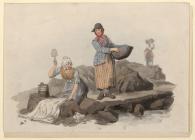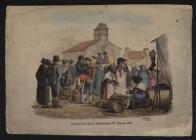Pyne, W.H., (1769-1843)
William Henry Pyne (1769-1843)
William Pyne produced hundreds of genre studies of working people in England specifically to assist amateur and professional artists. In the introduction to his ‘Rustic Figures for the Embellishment of Landscape, 1814-1815’ he stated that many artists did not put the same effort into representing figures as they did with the landscape, and often left them to add later. He urged his readers to study his drawings, which he claimed were from nature, to assist them in producing realistic portraits which recommended should be drawn on the spot so that ‘groups then assume the air of nature: their occupations are mostly accordant to the scene: and they are consequently appropriate in action, character and every essential that constitutes fitness of propriety.’ He advised artists to ‘study the works of those artists who have most excelled in forming pictures representing the peasantry of our country’ whom he named as Thomas Gainsborough (1727-1788), Richard Westall (1765-1836) whose ‘Boy of Glamorganshire’ and ‘Girl of Caernarvon’ were produced as prints; Joshua Cristall, ca.1767-1847 who was in Wales at the beginning of the 19th century; Thomas Barker of Bath (1769-1847), who was born in Pontypool and George Morland (1763-1804).
Pyne’s Costume of Great Britain (1808, 1810) includes no. 9 ‘Welsh Peasants Washing’ with an accompanying description. William Alexander published a version of this in his Picturesque representations of the dress and manners of the English… (1814), plate 47 with a much briefer description.
William Pyne was commissioned by Rudolph Ackermann to produce ‘Microcosm, A Picturesque Delineation of the Arts, Agriculture, Manufactures, etc of Great Britain in a series of above 600 Groups of Small Figures …’ which consisted of 641 groups in 120 aquatints by J Hill after Pyne’s drawings of people in rural settings at work, rest and play. It was first published in 30 sections between 1802-1807, then as a book in 2 volumes in 1808 by William Miller, and finally by Ackermann in 1824. It is said that some of the original drawings were by Thomas Rowlandson and Augustus Pugin. It was republished as Picturesque Views of Rural Occupations in Early Nineteenth-Century England (also known as Rustic Vignettes for Artists and Craftsmen) by Dover Publications, New York, 1977
Microcosm included two prints of groups of people at a market or fair. Two of these are in the National Library of Wales’s collection, nos. 85 (Basket makers and coopers) and 86 (Miscellaneous) neither of which appear to be set in Wales.
Plate 6 no. 3 of Microcosm is ‘Washing in Wales’ which is similar to his ‘Welsh Peasants Washing’ in 'Costume of Great Britain'.


